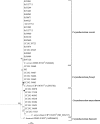Characterization of some bacterial strains isolated from animal clinical materials and identified as Corynebacterium xerosis by molecular biological techniques
- PMID: 20660219
- PMCID: PMC2937682
- DOI: 10.1128/JCM.02373-09
Characterization of some bacterial strains isolated from animal clinical materials and identified as Corynebacterium xerosis by molecular biological techniques
Abstract
Eighteen Corynebacterium xerosis strains isolated from different animal clinical specimens were subjected to phenotypic and molecular genetic studies. On the basis of the results of the biochemical characterization, the strains were tentatively identified as C. xerosis. Phylogenetic analysis based on comparative analysis of the sequences of 16S rRNA and rpoB genes revealed that the 18 strains were highly related to C. xerosis, C. amycolatum, C. freneyi, and C. hansenii. There was a good concordance between 16S rRNA and partial rpoB gene sequencing results, although partial rpoB gene sequencing allowed better differentiation of C. xerosis. Alternatively, C. xerosis was also differentiated from C. freneyi and C. amycolatum by restriction fragment length polymorphism analysis of the 16S-23S rRNA gene intergenic spacer region. Phenotypic characterization indicated that besides acid production from D-turanose and 5-ketogluconate, 90% of the strains were able to reduce nitrate. The absence of the fatty acids C(14:0), C(15:0), C(16:1)omega 7c, and C(17:1)omega 8c can also facilitate the differentiation of C. xerosis from closely related species. The results of the present investigation demonstrated that for reliable identification of C. xerosis strains from clinical samples, a combination of phenotypic and molecular-biology-based identification techniques is necessary.
Figures



References
-
- Almuzara, M. N., C. De Mier, C. R. Rodríguez, A. M. Famiglietti, and C. A. Vay. 2006. Evaluation of API Coryne System, version 2.0, for diphteroid [sic] gram-positive rods identification with clinical relevance. Rev. Argent. Microbiol. 38:197-201. - PubMed
-
- Aubel, D., F. N. Renaud, and J. Freney. 1997. Genomic diversity of several Corynebacterium species identified by amplification of the 16S-23S rDNA gene spacer region. Int. J. Syst. Bacteriol. 47:767-772.
-
- Fernández-Garayzábal, J. F., M. D. Collins, R. A. Hutson, F. Fernández, R. Monasterio, R. Marco, and L. Domínguez. 1997. Corynebacterium mastitidis sp. nov., isolated from milk of sheep with subclinical mastitis. Int. J. Syst. Bacteriol. 47:1082-1085. - PubMed
MeSH terms
Substances
Associated data
- Actions
- Actions
- Actions
- Actions
- Actions
- Actions
- Actions
- Actions
- Actions
- Actions
- Actions
- Actions
- Actions
- Actions
- Actions
- Actions
- Actions
- Actions
- Actions
- Actions
- Actions
- Actions
- Actions
- Actions
- Actions
- Actions
- Actions
- Actions
- Actions
- Actions
- Actions
- Actions
- Actions
- Actions
- Actions
- Actions
- Actions
- Actions
- Actions
- Actions
- Actions
- Actions
- Actions
- Actions
- Actions
- Actions
- Actions
- Actions
- Actions
- Actions
- Actions
- Actions
- Actions
- Actions
- Actions
- Actions
- Actions
- Actions
- Actions
- Actions
LinkOut - more resources
Full Text Sources
Molecular Biology Databases

